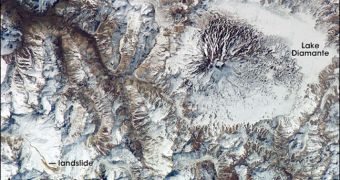In a groundbreaking discovery that could give researchers more clues about how life evolved on our planet, scientists in Argentina uncovered a whole range of mysterious microorganisms living in a deadly lake. Located inside the crater of a volcano in the Andes mountains, the lake appears to be normal, but holds a dark secret. Its waters are deadly, containing five times more salt than seawater, large concentrations of arsenic poison, and emanating fatal fumes and gases. Its highly-alkaline waters have a pH of no less than 11, the team reports, quoted by Nature News.
The Argentine team that made the finding says they were surprised to discover flamingo birds living around the lake, adapted to surviving in this remarkably-hostile environment. The group believes that analyzing these creatures could provide them with numerous new datasets, which could then be applied to a wide array of research fields. Additionally, the differences between the organisms living at this location and individuals of the same species living in “normal” conditions could give them more clues as to how life evolved in the harsh conditions that characterized our planet in the distant past.
While investigating the Andes, the researchers first came across the Socompa and Tolar Grande lagoons, which were found to be containing large amounts of living stromatolites. These are solid structures formed by microbes, photosynthetic microorganisms and various mineral accretions, which develop over millions of years. Intrigued by the findings, in February 2010, the team took to studying the desert plateau called Puna de Atacama, which lies about 4,000 meters (about 13,100 feet) above sea level. The Cerro Galan volcano, which is still active, was their target.
The researchers, based at the National Scientific and Technical Research Council in Tucuman, Argentina, and led by microbiologist María Eugenia Farias, looked at the mountain's caldera, which is one of the largest in the world. Inside, they found the Laguna del Diamante lake, which did not contain stromatolites, but mysterious microbes and flamingo birds that appeared to thrive at the deadly location. The level of arsenic in the waters has been established to be about 20,000 higher than the one considered safe for human consumption, as per the instructions of the US Environmental Protection Agency (EPA).

 14 DAY TRIAL //
14 DAY TRIAL //